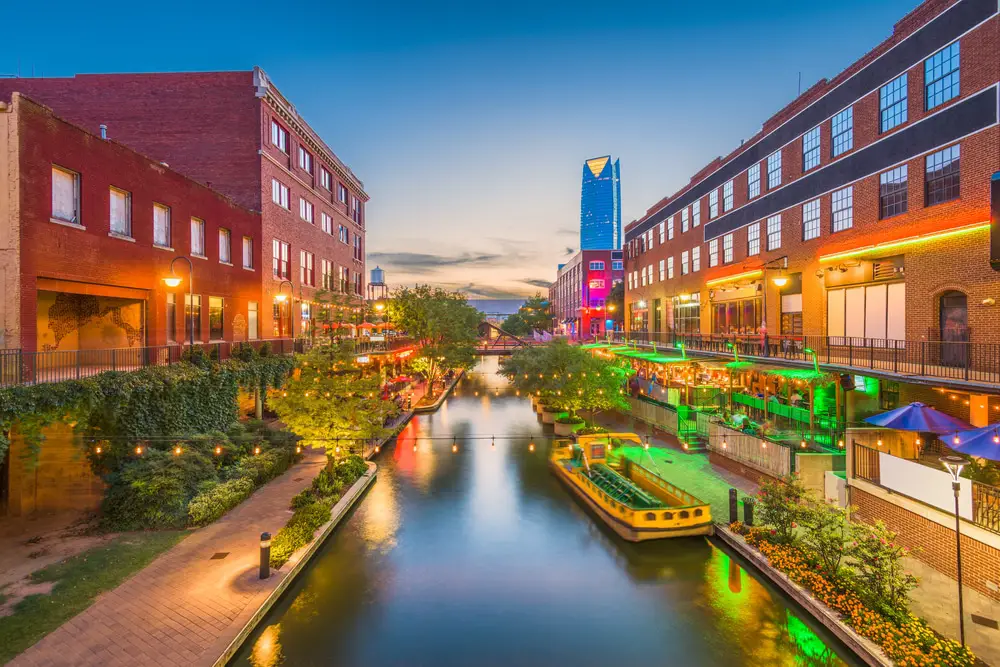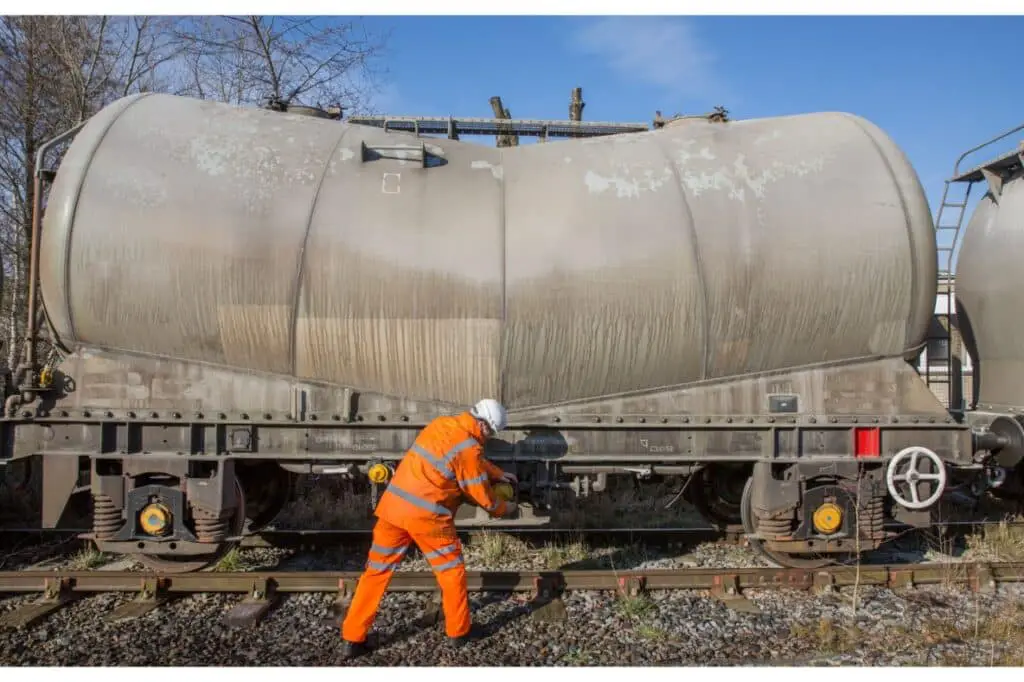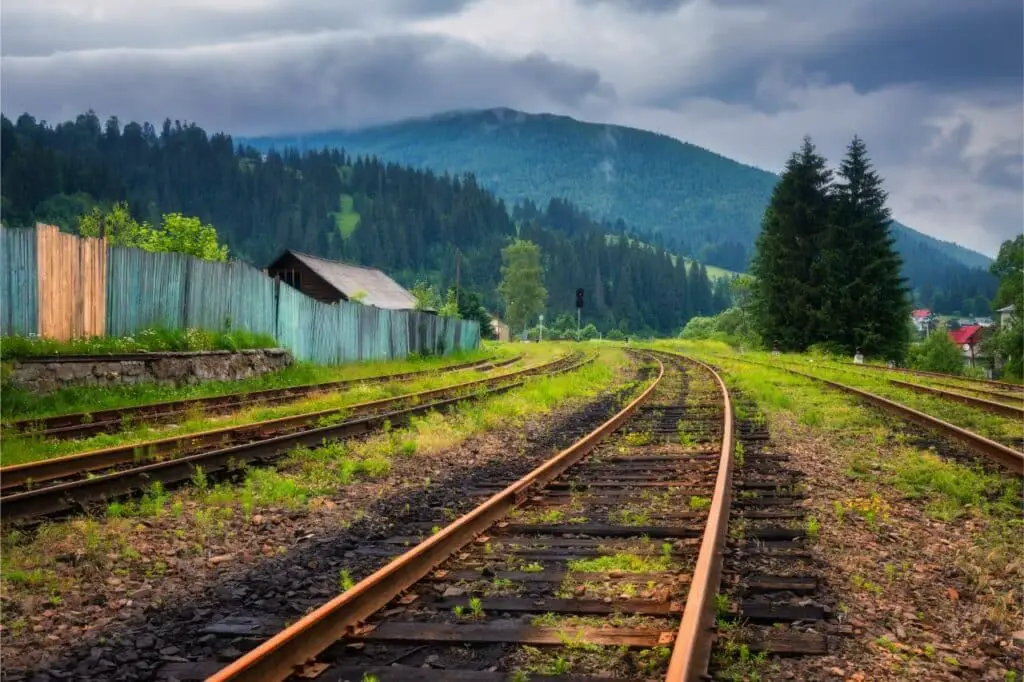Are you searching for railroad jobs in Oklahoma? You’ll be happy to know that you’ve got pretty good options. The state of Oklahoma is home to three major Class I networks. These are BSNF, KCSR, and The Union Pacific. Oklahoma also has one class II regional railroad, the South Kansas & Oklahoma.

Finally, the state boasts a handful of Class III shortlines. In fact, these rails account for about 30-35% of the state’s trackage.
That said, you can expect a wide range of possibilities. All in all, Oklahoma totals 4,000 miles of trackage with about 19 freight railways.
It’s also worth noting that Oklahoma has a rich railroad heritage.
It had many famous western and granger rails under its roster. This includes the Missouri Pacific, Frisco, and Sante Fe. Almost all of these networks wanted to access the state’s wealthy agricultural areas.
The state was also highly known for the cattle trade. At its peak, Oklahoma housed over 6,500 miles of trackage in 1920.
Unfortunately, just like all the other states, most of these were abandoned. The state’s rail diminished by nearly 50%.
But, it still holds great value today. In fact, rail is one of the state’s economic drivers.
Working for the railroad is a rewarding experience. But, finding a job can be difficult if you don’t know where to start. So, we’ve placed all the information you need to start your job hunt.
In this post, we list down railroad companies in Oklahoma that you can apply for. Prior to that, we delve a bit deeper into the economic importance of Michigan’s rail system.
And finally, we add in a few pointers for new prospective railroaders.
Let’s get started.

Oklahoma’s Freight Rail System: Economic Value
The state’s freight infrastructure plays a big role in the state’s supply chain. Rail links the state’s businesses, farmers, and shippers to a vast North American market.
It also connects them to global markets through multimodal networks. In 2014, Oklahoma transported a total of 365 million tons worth of freight. This equates to about 7.3 million railcars.
Despite being known for agriculture, only 10% of rail freight comes from farming. Non-metallic minerals and chemicals are what actually account for the bulk of freight.
Oklahoma’s most shipped commodities (as of 2014) with figures are as follows:
- Coal (over 123 million tons)
- Nonmetallic minerals (over 45 million tons)
- Mixed shipments (over 28 million tons)
- Farm goods (35 million tons)
- Hazardous materials (over 29 million tons)
Apart from these, Oklahoma businesses benefit from the financial and logistical benefits of rail freight.
It offers a cost-effective option for shipping and transporting items compared to trucks.
Rail is also much more fuel-efficient compared to trucks in terms of miles traveled, together with the production of greenhouse gases. Rail freight can reduce up to 70% of greenhouse gasses for each ton-mile.
The rail sector is also a job-generating business. For instance, both freight and passenger rail can generate nearly 2,000 jobs.
Overall, Oklahoma’s rails reap a total economic output of 6 billion dollars.
Overall, railways have advantages over other forms of transportation that other modes don’t. So, it can be very rewarding to work in this field.
However, there are a few things you should know if you’re just getting started in the industry.

Working For The Railroad in Oklahoma: Things To Consider
Oklahoma has a unique variety of landscapes. The southern area of Oklahoma boasts wonderful high and green mountains. Whereas its western half boasts the familiar American plains.
They’re flat and wide countrysides dotted with farms. So, you can expect a different range of sceneries whilest on the job.
You’ve probably heard the nicest things about railroading. This includes generous wages, benefits, and programs. While these are definitely true, you might not have heard about the other aspects of railroading.
First off, it can be a pretty demanding, physically and mentally taxing job. Most crews and maintenance workers in Class I jobs work 12-hour days.
Also, It’s not uncommon to have to report to work on the weekends or on holidays, too. Due to this, you may have to spend a lot of time away from your family.
BUT, Class Is paid some of the best wages in the sector. In addition, they provide a host of other benefits, including retirement plans.
So, it can be well worth the effort and sacrifice.
If you don’t want to put in long hours, consider working on shortlines. Schedules are more predictable and flexible here.
However, the income may not be as great as a Class I job.
A typical Oklahoman railroader can make up to $37,000 yearly. However, this depends on your skills, the company, and other factors. After a few years of working, you can even make close to six figures.
Finally, if you’re a college student, keep an eye out for programs. you may get valuable work experience by interning at one of the many Class I corporations.
In most cases, these are the decisive factors for prospective railroaders. The choice is yours to make at the end of the day.

Class I Railroad Jobs in Oklahoma
BNSF Railway
The Burlington Northern and Santa Fe Railway, or BNSF, has been around since 1995. It is among seven of North America’s major class I railroads.
This railway is the result of almost 400 acquired or merged railroad lines. In total, the network boasts 32,500 miles of trackage. Their locomotives run in 28 states of America.
This network is also one of the top intermodal freight carriers in the north. In addition, they carry ample coal — enough to create around 25 percent of the nation’s electricity. Moreover, they are one of the highest-compensating railroad employers.
Check out railroad jobs at BNSF here.
Kansas City Southern Railway
The Kansas City Southern Railway Company commenced in 1887. KCS travels within 10 southeastern and midwestern states in America. This includes:
- Illinois
- Missouri
- Kansas
- Oklahoma
- Arkansas
- Tennessee
- Alabama
- Mississippi
- Louisiana
- Texas
They also carry a wide variety of freight for businesses and the government. These include the military, industrial, intermodal, consumer products, and more.
In contrast with BNSF, KCSR is not a product of merged and acquired railways. Instead, they own or have intermodal facilities with Kansas City.
Overall, this class I network totals 3,400 miles of trackage. Its routes stretch from the border of Mexico to the United States. Here, it links with Kansas City Southern de México, a KCS-owned network. Finally, this network can bring freight into Mexico and its ports.
Employee reviews online average from 3.2-3.5 stars from 5. Most reviews state that they would recommend KCS to others.
Learn more about KCSR by clicking here.
Union Pacific
The Union Pacific Railroad is the second-largest railroad in the country. It comes just behind BNSF. They are also the first-ever transcontinental railroad.
The company has more than 8,000 locomotives under its roster. In total, the network runs 32,200 miles of track. Its route travels through 23 states in America.
This class I network is also known to be one of the best companies to work with. Non-management employees are required to be members of a union. The following health advantages will be yours as a result:
- Medical insurance
- Disability and life insurance
- Dental insurance
- Vision insurance
Apart from these, the company also offers generous retirement plans and programs.
Interested in working for them? Click here.

Class II Regional Railroad Jobs in Oklahoma
South Kansas and Oklahoma Railroad
This only regional Oklahoma railroad operates 511 miles of trackage. SKOL travels through Kansas, Missouri, and Oklahoma. Moreover, South Kansas and Oklahoma is a Watco-owned regional.
They also do interchanges wth all three class I railroads in the state.
Learn more about them through Watco’s website. Click here.
Class III Shortline, Terminal, and Switching Railroad Jobs in Oklahoma
Arkansas-Oklahoma Railroad
The Arkansas–Oklahoma Railroad has its headquarters in Wilberton. They currently run two potions of the historical Chicago, Rock Island, and Pacific Railroad.
All in all, this shortline runs a total of 70 miles of trackage.
Learn more about them by clicking here.
Arkansas Southern Railroad
The Arkansas Southern is part of Watco’s shortline roster. They started operations back in 2005. This shortline travels through two disconnected lines.
One totals 32 miles from Heavener to Waldron. The latter travels through a 29-mile route in Ashdown to Arkansas.
They operate switching in Ashdown, too. All in all, Arkansas Southern runs 63 miles of trackage. Check out Watco’s website for more information. Click here.
AT&L Railroad
This is a Wheeler Brothers Grain-owned shortline. The ATLT operates a total of 49 miles of track through an old CRI&P line. This shortline also took over the North Central Oklahoma Railway.
They’re a freight railway that runs to Watonga, Geary, and El Reno. Additionally, it travels within Greenfield and Calumet. Lastly, they haul grain, agricultural goods, and fertilizer.
Blackwell Northern Gateway Railroad
The BNG is owned by the Oklahoma Department of Transportation and Blackwell Industrial Authority. On top of this, US Rail Partners, Ltd. operates its tracks.
It also interchanges with class I BNSF and Union Pacific. All in all, they run 35 miles of trackage. Learn more about them by clicking here.
Cimarron Valley Railroad
The Cimarron Valley Railroad (CVR) commenced in the 1910s. They run through Oklahoma, Kansas, and Colorado — through the old Atchison, Topeka, and Santa Fe Railroad. One route travels in Dodge and Boise.
On the other hand, the other travels through Santana and Springfield. All in all, they boast 254 miles of trackage.
Moreover, they haul wheat, corn, and other agricultural goods. Jaguar Transport Holdings recently bought the railroad in 2020.
De Queen & Eastern Railroad
This shortline is owned by the Patriot Rail Company. This line is also operated by its partner, the Texas, Oklahoma, and Eastern Railroad. Overall, DQE operates a total of 91 miles of trackage.
Their routes span from the west to Perkins, Dierks, and Dequeen.
Farmrail Corporation
This employee-owned company is headquartered in Clinton. Farmrail mainly serves agricultural goods, hence its name.
It mostly runs through the western parts of Oklahoma. Moreover, they operate tourist or excursion trains over the summertime.
Learn more about them through their company website. Click here.
Kiamichi Railroad
Kiamichi is a Genesee & Wyoming-owned railroad. Overall, it operates roughly 360 miles of track. Additionally, its routes travel through Arkansas, Hope, and Lakeside.
It also has branches that stretch out to Antlers and Texas (Paris.) Find more information about them by clicking here.
Northwestern Oklahoma Railroad
This very short, shortline operates only 5 miles of track. It mainly serves Woodward with switching services.
They also do interchanges in Woodward with Class I BNSF. Additionally, they haul pipes, drilling mud, and sand to the oil sector.
Sand Springs Railway
This shortline has been around since the 1910s. The Sand Springs Railway used to be an interurban line. However, their passenger service was discontinued in 1955.
Today, it hauls freight in Tulsa and Sand Springs. All in all, this shortline runs 32 miles of track.

Stillwater Central Railroad
Another Watco-owned shortline on this list is Stillwater Central. They have a total of 275 miles of trackage. Additionally, they run through Sapulpa, Lawton, and Sydner. Learn more about them by clicking here.
Tulsa-Sapulpa Union Railway
The Tulsa-Sapulpa Union Railway Company operates only 10 miles of track. It serves only the Tulsa and Sapulpa region, hence its name.
The company also operates nearly 13 miles of track in Union Pacific’s network.
Begin Your Railroad Career With These Railroad Jobs in Oklahoma!
So, there you have it. Oklahoma offers a good range of career options for any railroader. The state has three major class I networks. With this alone, you’ve already got a lot of choices. Plus, you’ve got regionals and tons of shortlines to consider.
Contact any of these companies if you’re interested.
It can be quite exciting to have many options. But, don’t rush into things quickly, especially if you’re freshly coming into the sector.
Know what works for you and what doesn’t. This way, you can find a position that’s a good fit for you.
Finding a job isn’t always going to be a walk in the park. The employment market may be tough and saturated at times.
However, don’t give up. You’ll be able to locate a career on the railroad that meets your needs. It will all payout in the end.
Not completely decided on Oklahoma yet? We can help you broaden your choices. We have a list of railroad jobs per state. Click here. Also, keep an eye on our website if you’re interested in learning more about the railroads.
That finally wraps up our railroad jobs in Oklahoma.
We hope that we were able to help you with your job hunt.
Best of luck in your job search and railroad career!
